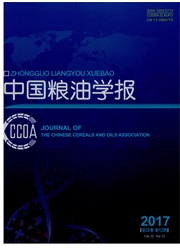

 中文摘要:
中文摘要:
生鲜面的颜色和褐变不仅与小麦的品种有关,还可能与面粉中主要组分的含量和比例有关.通过对面粉主要组分进行分离和重组,评价不同组分对生鲜面的颜色和褐变程度的影响.结果表明:蛋白质和淀粉含量与生鲜面的初始色差值呈极显著相关(P<0.01),而蛋白含量与其24 h内褐变量无显著相关性,不同蛋白含量的面片在初始阶段的褐变程度不同;直链淀粉含量与面片的初始L*值和a*值呈显著负相关(P<0.05),与b*值呈极显著正相关(P<0.01),且随直链淀粉含量的增加,面片褐变速率增大,24h内的L*值变化△L24~0h显著增加,支链淀粉比例增加能够延缓生鲜面的褐变;一定范围内随着脂肪含量的增加,生鲜面片的褐变能够得到一定的延缓.
 英文摘要:
英文摘要:
Color and darkening degree of fresh noodles may attribute to both wheat varieties and the main components in wheat flour. The main components of flour have been separated and restructured to assay the changes in fresh noo- dle color and the browning rate in the paper. The results showed that the protein and starch content were significantly correlated with the initial color of fresh noodles( P 〈 0.01 ). However, there was no significant correlation detected between protein content and the browning rate within 24 h. Noodle sheets with various protein contents showed differ- ent browning degree at the initial stage. Amylose content in wheat flour negatively correlated with the L * value and a * value of fresh noodles while significantly positively correlated (P 〈0.01 ) with b * value. In addition,browning rate of fresh noodles had significantly increased with the increase of amylose content, so did the AL24_0 h value. The result showed that browning rate of fresh noodles can be delayed with the increase of amylopectin. Within a given range, increased fat content could inhibit the browning of fresh noodles.
 同期刊论文项目
同期刊论文项目
 同项目期刊论文
同项目期刊论文
 期刊信息
期刊信息
